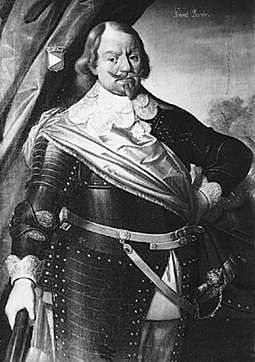Johan Banér facts for kids
Quick facts for kids
Johan Banér
|
|
|---|---|

Johan Banér
|
|
| Born | 23 June 1596 Djursholm Castle, Sweden |
| Died | 10 May 1641 (aged 44) Halberstadt, Saxony |
| Allegiance | Sweden |
| Service/ |
Swedish Army |
| Years of service | 1615–1641 |
| Rank | Field Marshal |
| Battles/wars | Ingrian War Polish-Swedish War (1620–1622) Polish-Swedish War (1625–1629) Thirty Years' War |
| Other work | Privy Councillor |
Johan Banér (born June 23, 1596 – died May 10, 1641) was a very important Swedish military leader. He became a field marshal, which is a very high rank in the army. He played a big part in the Thirty Years' War, a major conflict in Europe during the 1600s.
Contents
Early Life and Family
Johan Banér was born at Djursholm Castle in Uppland, Sweden. When he was only four years old, his father, Gustaf Banér, and his uncle, Sten Axelsson Banér, faced serious accusations from King Charles IX. They were accused of being disloyal to the king.
Even though King Gustavus Adolphus was the son of the king who had accused Banér's father, Johan and Gustavus Adolphus became very good friends. This friendship grew stronger after Gustavus Adolphus became king and brought the Banér family back into favor.
Military Career and Major Battles
Johan Banér joined the Swedish Army in 1615. His first experience in battle was during the Ingrian War, when Sweden tried to capture the city of Pskov. Even as a young soldier, he showed great bravery and skill.
He served well in wars against Russia and Poland. By the time he was 25, he had already become a colonel, a high rank for someone so young.
Fighting in the Thirty Years' War
In 1630, King Gustavus Adolphus brought the Swedish army to Germany to fight in the Thirty Years' War. Johan Banér was one of the king's most trusted commanders. He helped lead the Swedish forces in northern Germany.
At the first Battle of Breitenfeld in 1631, Banér led the right side of the Swedish cavalry (soldiers on horseback). This battle was a big victory for Sweden. He was also involved in taking important cities like Augsburg and Munich. He showed great courage at the Lech and Donauwörth.
Later, Banér was injured during an attack on a camp led by the enemy general Albrecht von Wallenstein. After King Gustavus Adolphus moved his army towards Lützen, Banér was left in charge of the western army.
Victories and Challenges
Two years later, as a Swedish field marshal, Banér led 16,000 soldiers into Bohemia. He joined forces with the Saxon army and planned to march on Prague. However, a major defeat for another Swedish general at the first Battle of Nördlingen stopped Banér's advance.
After this, the Peace of Prague made things difficult for the Swedish army. But Banér, working with another general named Alexander Leslie, won a very important victory at the Wittstock on October 4, 1636. This battle helped Sweden regain its strong position in central Germany. Banér himself said that General Leslie's help was crucial for their victory.
Despite this success, Banér's army was often smaller than the enemy's. In 1637, he found it hard to make progress. He managed to rescue the Swedish soldiers stuck in Torgau and then retreated to Pomerania.
Final Campaigns and Legacy
In 1639, Banér again led his army through northern Germany. He defeated the Saxons at the Chemnitz and then moved into Bohemia.
During the winter of 1640–1641, Banér made a very bold move. He broke camp in the middle of winter, which was very unusual for armies back then. He joined forces with the French army and surprised the city of Regensburg, where an important meeting was taking place. They almost captured the city, but the ice on the Danube river broke, making it impossible to cross.
Banér then had to retreat to Halberstadt. He died there on May 10, 1641, after some health issues. Before he died, he named Lennart Torstenson as his successor. His soldiers loved him very much and carried his body with them to the Battle of Wolfenbüttel. He was buried in the Riddarholmen Church in Stockholm.
Johan Banér was known as a very skilled general, especially during the time of Queen Christina. He was offered chances to join the enemy's side but always refused, staying loyal to Sweden.
Family Life
In 1623, Johan Banér married Catharina Elisabeth von Pfuel. She was a lady-in-waiting to Queen Maria Eleonora of Sweden. Catharina died in 1636.
Later that same year, on July 25, 1636, Banér married Countess Elisabeth Juliana von Erbach. She passed away in 1640.
After his second wife's death, he married for a third time to Margravine Johanna von Baden-Durlach. Johan Banér only had children with his first wife, Catharina. His son from that marriage, Gustaf Adam (1624-1681), later received the special title of Count Banér af Sortavala.
See also
 In Spanish: Johan Banér para niños
In Spanish: Johan Banér para niños


